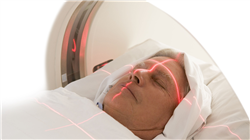University certificate
The world's largest faculty of medicine”
Introduction to the Program
Through this Postgraduate diploma, based on Relearning, you will handle the most cutting-edge techniques of Artificial Intelligence and Big Data to optimize the quality of your clinical diagnoses”

A new study prepared by the World Health Organization estimates that 70% of diagnostic errors in Medical Imaging can be reduced by using Artificial Intelligence. An example of this is that the analysis of imaging tests by Magnetic Resonance Imaging has enabled the early detection of Neurodegenerative Pathologies such as Alzheimer's disease by 30% compared to traditional methods. Faced with this, physicians need to stay at the forefront of advances in this field in order to make more informed clinical decisions and personalize therapies to optimize the health of patients significantly.
In this scenario, TECH presents an innovative program in Artificial Intelligence and Big Data Technologies for Medical Imaging Processing. The academic itinerary will delve into issues ranging from the use of Deep Learning or Convolutional Neural Networks to the most sophisticated Machine Learning techniques. In this way, graduates will develop advanced clinical skills that will enable them to make more accurate diagnoses in early stages. Likewise, the syllabus will offer various modeling methods to predict both the onset and progression of diseases, which will help professionals to carry out preventive interventions. In addition, the didactic materials will delve into the ethical and legal considerations of the use of Artificial Intelligence in the healthcare field.
On the other hand, to consolidate all these contents, TECH relies on its disruptive Relearning system. This teaching method is based on the repetition of key contents, to guarantee a progressive and natural updating of knowledge. In addition, the only thing that graduates will need is a device with Internet access to access the study materials remotely, at the time or place of their choice. On the other hand, in the Virtual Campus they will find a variety of multimedia resources such as case studies, interactive summaries or explanatory videos.
You will enjoy state-of-the-art multimedia resources such as specialized readings supported by the latest scientific findings in the field of Medical Image Processing”
This Postgraduate diploma in Artificial Intelligence and Big Data Technologies for Medical Imaging Processing contains the most complete and up-to-date scientific program on the market. The most important features include:
- Development of practical cases presented by experts in Artificial Intelligence
- The graphic, schematic and eminently practical contents with which it is conceived gather scientific and practical information on those disciplines that are indispensable for professional practice
- Practical exercises where self-assessment can be used to improve learning
- Its special emphasis on innovative methodologies
- Theoretical lessons, questions to the expert, debate forums on controversial topics, and individual reflection assignments
- Content that is accessible from any fixed or portable device with an Internet connection
TECH provides you with a 100% online methodology, based on free access to the didactic contents, which you will be able to carry out while developing your full-time professional work”
The program’s teaching staff includes professionals from the field who contribute their work experience to this educational program, as well as renowned specialists from leading societies and prestigious universities.
The multimedia content, developed with the latest educational technology, will provide the professional with situated and contextual learning, i.e., a simulated environment that will provide immersive education programmed to learn in real situations.
This program is designed around Problem-Based Learning, whereby the professional must try to solve the different professional practice situations that arise during the course. For this purpose, students will be assisted by an innovative interactive video system created by renowned and experienced experts.
Do you want to implement the most innovative Big Data techniques in your daily clinical practice? With this university program you will achieve it"

You will delve into predictive modeling with IBM Watson Oncology, which will allow you to perform exhaustive follow-ups of various Chronic Diseases"
Why study at TECH?
TECH is the world’s largest online university. With an impressive catalog of more than 14,000 university programs available in 11 languages, it is positioned as a leader in employability, with a 99% job placement rate. In addition, it relies on an enormous faculty of more than 6,000 professors of the highest international renown.

Study at the world's largest online university and guarantee your professional success. The future starts at TECH”
The world’s best online university according to FORBES
The prestigious Forbes magazine, specialized in business and finance, has highlighted TECH as “the world's best online university” This is what they have recently stated in an article in their digital edition in which they echo the success story of this institution, “thanks to the academic offer it provides, the selection of its teaching staff, and an innovative learning method aimed at educating the professionals of the future”
A revolutionary study method, a cutting-edge faculty and a practical focus: the key to TECH's success.
The most complete study plans on the university scene
TECH offers the most complete study plans on the university scene, with syllabuses that cover fundamental concepts and, at the same time, the main scientific advances in their specific scientific areas. In addition, these programs are continuously being updated to guarantee students the academic vanguard and the most in-demand professional skills. In this way, the university's qualifications provide its graduates with a significant advantage to propel their careers to success.
TECH offers the most comprehensive and intensive study plans on the current university scene.
A world-class teaching staff
TECH's teaching staff is made up of more than 6,000 professors with the highest international recognition. Professors, researchers and top executives of multinational companies, including Isaiah Covington, performance coach of the Boston Celtics; Magda Romanska, principal investigator at Harvard MetaLAB; Ignacio Wistumba, chairman of the department of translational molecular pathology at MD Anderson Cancer Center; and D.W. Pine, creative director of TIME magazine, among others.
Internationally renowned experts, specialized in different branches of Health, Technology, Communication and Business, form part of the TECH faculty.
A unique learning method
TECH is the first university to use Relearning in all its programs. It is the best online learning methodology, accredited with international teaching quality certifications, provided by prestigious educational agencies. In addition, this disruptive educational model is complemented with the “Case Method”, thereby setting up a unique online teaching strategy. Innovative teaching resources are also implemented, including detailed videos, infographics and interactive summaries.
TECH combines Relearning and the Case Method in all its university programs to guarantee excellent theoretical and practical learning, studying whenever and wherever you want.
The world's largest online university
TECH is the world’s largest online university. We are the largest educational institution, with the best and widest online educational catalog, one hundred percent online and covering the vast majority of areas of knowledge. We offer a large selection of our own degrees and accredited online undergraduate and postgraduate degrees. In total, more than 14,000 university degrees, in eleven different languages, make us the largest educational largest in the world.
TECH has the world's most extensive catalog of academic and official programs, available in more than 11 languages.
Google Premier Partner
The American technology giant has awarded TECH the Google Google Premier Partner badge. This award, which is only available to 3% of the world's companies, highlights the efficient, flexible and tailored experience that this university provides to students. The recognition as a Google Premier Partner not only accredits the maximum rigor, performance and investment in TECH's digital infrastructures, but also places this university as one of the world's leading technology companies.
Google has positioned TECH in the top 3% of the world's most important technology companies by awarding it its Google Premier Partner badge.
The official online university of the NBA
TECH is the official online university of the NBA. Thanks to our agreement with the biggest league in basketball, we offer our students exclusive university programs, as well as a wide variety of educational resources focused on the business of the league and other areas of the sports industry. Each program is made up of a uniquely designed syllabus and features exceptional guest hosts: professionals with a distinguished sports background who will offer their expertise on the most relevant topics.
TECH has been selected by the NBA, the world's top basketball league, as its official online university.
The top-rated university by its students
Students have positioned TECH as the world's top-rated university on the main review websites, with a highest rating of 4.9 out of 5, obtained from more than 1,000 reviews. These results consolidate TECH as the benchmark university institution at an international level, reflecting the excellence and positive impact of its educational model.” reflecting the excellence and positive impact of its educational model.”
TECH is the world’s top-rated university by its students.
Leaders in employability
TECH has managed to become the leading university in employability. 99% of its students obtain jobs in the academic field they have studied, within one year of completing any of the university's programs. A similar number achieve immediate career enhancement. All this thanks to a study methodology that bases its effectiveness on the acquisition of practical skills, which are absolutely necessary for professional development.
99% of TECH graduates find a job within a year of completing their studies.
Postgraduate Diploma in Artificial Intelligence and Big Data Technologies for Medical Imaging Processing
The use of artificial intelligence and Big Data technologies in the medical field is revolutionizing the way clinical images are processed and analyzed. These innovations enable greater accuracy in diagnoses and optimize the handling of large volumes of data, which is crucial for the advancement of modern medicine. For this reason, The Postgraduate Diploma in Artificial Intelligence and Big Data Technologies for Medical Imaging Processing of TECH Global University is presented as a unique opportunity for those professionals seeking to specialize in this field of growing relevance. This postgraduate diploma is taught through online classes, which provides participants with the flexibility needed to make their professional life compatible with their studies. During the program, students will explore in depth the use of artificial intelligence algorithms and Big Data techniques to improve the quality and speed of medical image analysis.
Leading the medical field using AI and Big Data
TECH Global University stands out for its commitment to innovation and educational excellence. Through this postgraduate diploma, participants will learn how to handle advanced tools that integrate artificial intelligence into diagnostic imaging, from X-rays to MRIs. In addition, the program includes an exhaustive analysis of the ethical and regulatory challenges involved in the use of these technologies in the healthcare field. At the end of the program, professionals will be prepared to contribute significantly to the development of technological solutions that optimize medical image processing. This specialization will not only enhance their capabilities, but will also open up new job opportunities in a constantly evolving industry. In an environment where technology and medicine converge, this postgraduate course is an invaluable tool for those who wish to make a difference in health care. Take advantage and enroll today.







